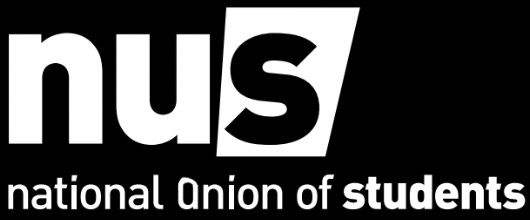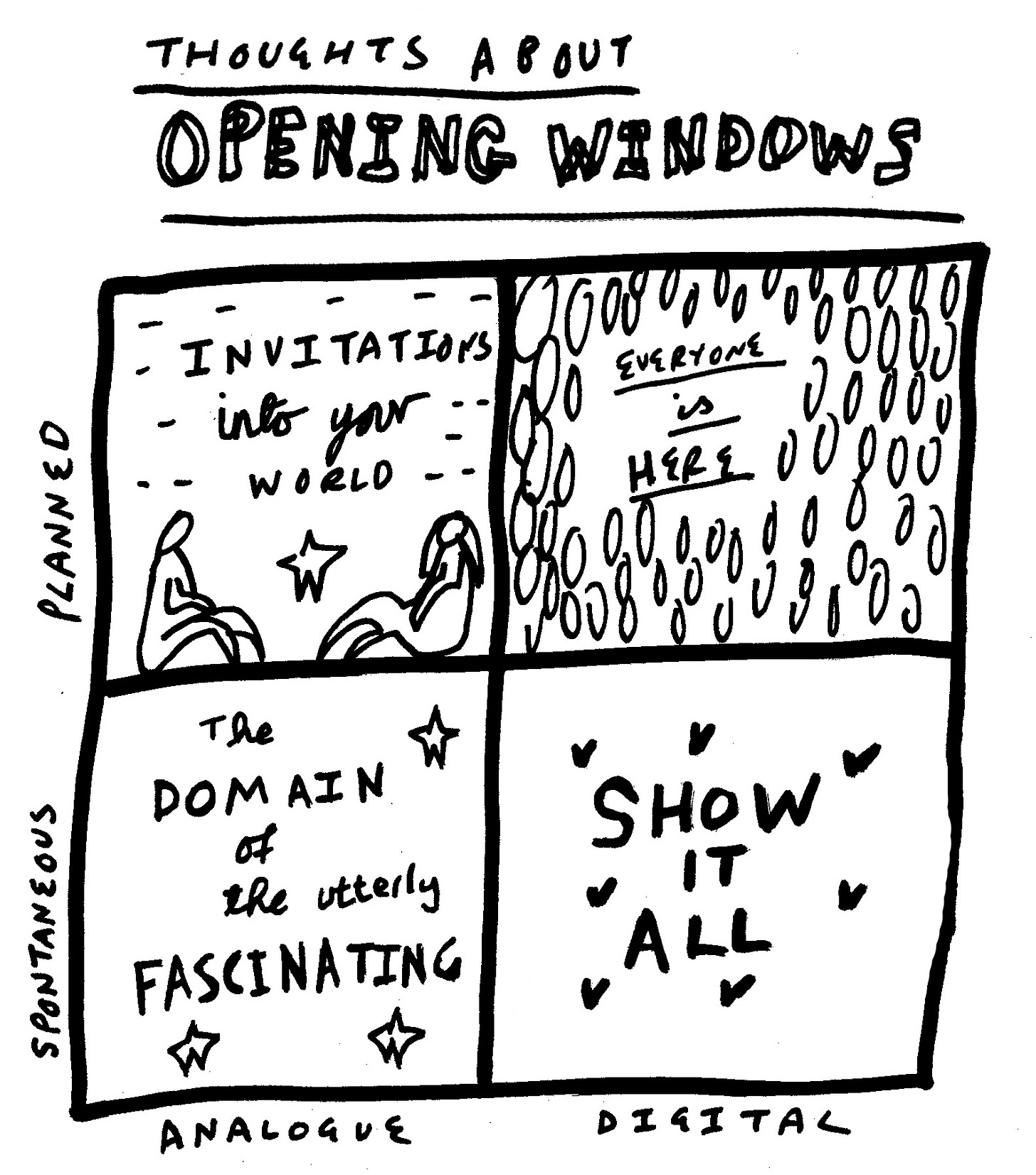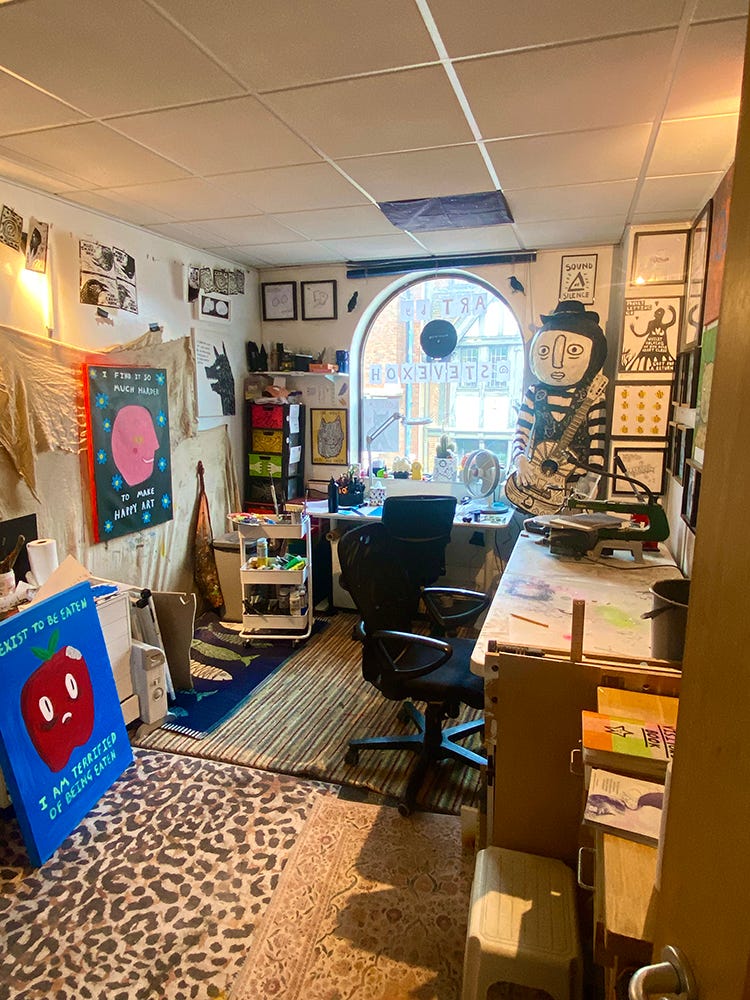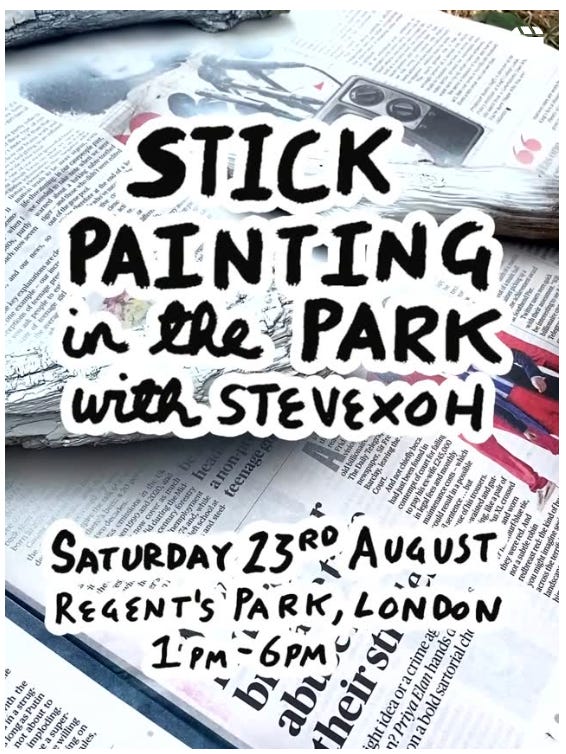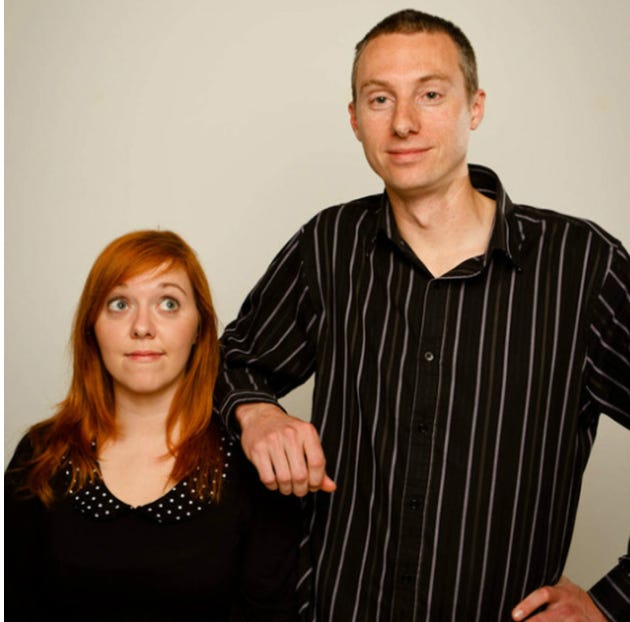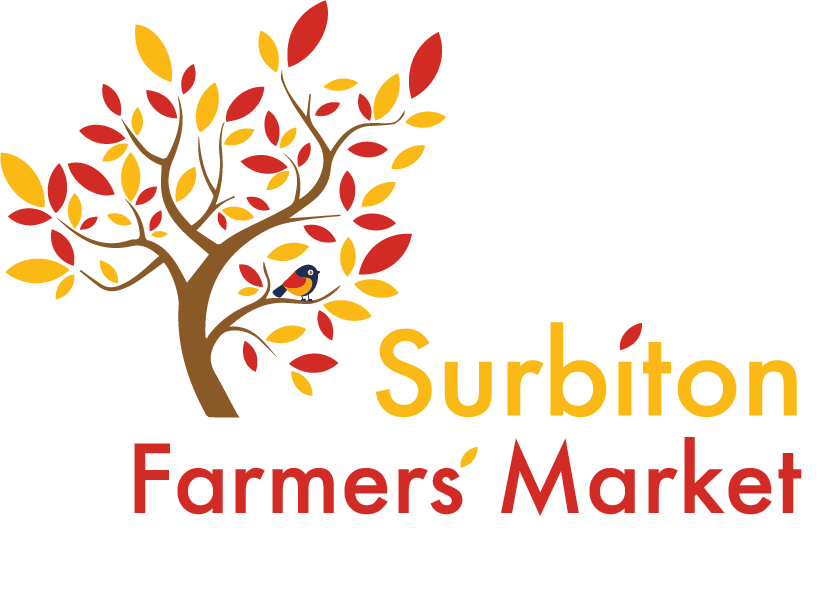Issue #2: The union of onions, the trouble with windows and the importance of niche environments and reasonable adjustments.
A rambling collection of words, wonderings, workshops and wonderful things to buy.
TL;DR
If you join the top of the letter “U” in the word “Union” it turns into “Onion”.
RAMBLINGS: Opening windows into your world seemed to be the trickiest of my four philosophies in my last substack and it is hard to think beyond planned, digital windows - so a rule of thumb might be to focus on analogue, spontaneous ones.
ARTICLE: The concepts of niche environments and reasonable adjustments feel important not just to neuro-diverse humans navigating the world but anyone wanting to nurture their creative spontaneous self-expression.
WORKSHOP/GATHERING : 23rd August - Stick painting in Regent’s park
This substack is free but you can support my work in other ways: Buy stuff in my shop, become a patron of my studio or buy me a coffee (tip jar).
1. Hello
I was on a packed underground train the other day and somebody in front of me (right in my face to be precise) had a rucksack with “Union” written on it. I’m not sure if it is a dyslexic thing or if everyone does it but I often read the letters of words in a different order or notice something in the character shapes which drains the word of its original meaning. This can be a bit annoying/problematic when trying to read but also a source of amusement and ideas. On this occasion I stared at the word union so much that I suddenly realised if I joined the top of the two sides of the letter U it would spell “Onion”. (I resisted doing this to the stranger’s backpack). This has changed the word “Union” for me for ever (which is extra interesting as I occasionally work with a couple of trade unions, now known as trade onions).
I was so pleased with the reaction to the first issue of this substack: the amount of people that read it, the amount of people who shared it and sent me messages and the amount of new subscribers (welcome.) The majority of comments and questions I received were about the “Four lightly held philosophies for living a creative life” article and in particular the idea of opening windows into your world as a way of re-thinking how we share our work with others and make new connections. (If you’d like to read the full article you can here).
Lots of people said that the windows philosophy was the most exciting and helpful but also the most challenging. Many said that they found it hard to think beyond digital windows like websites and social media posts. I found this really interesting and it got me thinking about the weird, somewhat paradoxical stuckness that the digital age has created. There is an abundance of digital platforms, used by millions, on which we can share our work with the entire world (in theory) but, at the same time, this abundance has potentially limited our imagination when it comes to thinking of other, more traditional ways of sharing our work. Many of us end up in a frustrating, demotivating stuck pattern where we try even harder to come up with ways of making the digital windows work for us whereas the answer maybe lies in ignoring it all together. Or at least weaning ourselves off of it a little.
In the conversations I had with people about this on the back of the article, I found myself thinking that digital windows should be our last resort, or at least a less important of our practice. Instead it feels more helpful to focus our time and energy on experimenting with more spontaneous analogue windows. I drew a little four box grid to explore this.
Now this isn’t a well thought through theory beyond the 3 minutes it took me to draw it. And I’m not even sure if the four box grid makes sense, but for me it offers an invitation to disrupt my habitual thinking, provoke my imagination and encourage experimentation. If there is any theory behind it then it is this: analogue encounters are far more intriguing and fascinating windows into the world of others. I’m more likely to look at and remember at a weirdo doing something unusual and creative in a park than I am from seeing a photo on Instagram, a video on Tik Tok or visiting a website. And, in my experience, the more spontaneous and unplanned the experiment is, the more alive and “real” it feels in a way that makes it even more compelling.
My globally viral “(Not a) Lost Cat” project began as a spontaneous analogue experiment. I was bored one day and, inspired by a real lost cat poster, I painted my own fake one. A few days I later put up 10 copies of the poster in central London for no reason other than I thought it would be an interesting thing to do. These posters proved fascinating to people who saw them and many got in contact asking if they could have one to put up somewhere and, to cut a long story short, over 5,000 of these posters ended up being put up in 56 countries on every single continent (including Antarctica). The “(Not a) Lost Cat” project became a massive window into my world and lead to people buying art from my shop, contacting me about projects and workshops and inviting me to do talks about it all. (It was also featured in national newspapers, national radio and on a plethora of blogs across the internet). I subsequently used social media and my website to nurture and support the project’s growth but it all started from the seed of a spontaneous, analogue window into my world from 10 cheap posters I put up in London. (You can read the full story of the (Not a) Lost Cat project here)
Similarly, stick painting in the park was a spontaneous, analogue thing that I did in the spur of a moment because I was feeling low, had little money and was house-sitting next to a park with a load of sticks in it. In the end it proved to be an important window into my world that connected me with strangers and people who would become followers, friends and collaborators. I suspect that had I planned an instagram post or website page about stick painting or the (Not a) Lost Cat project in advance of just doing them then it wouldn’t have unfurled in the same way. I simply used the digital platforms to amplify and grow what had emerged spontaneously from “real world” encounters with my work.
I’m tempted to write more about all of this and explore my grid further but I think I would end up over-explaining it and drain the mystery out of it all. Also, I really don’t have any answers to any of this as I am constantly working it out for myself. I offer this little response to your questions and comments as a way of hopefully simultaneously helping whilst confusing further.
I’m doing a “Paint sticks in the park with stevexoh” thing on the 23rd August if you’d like to come and join me. (A planned, analogue window that emerged from the spontaneous one a few years back). If you’d like to come along you can find out more info here and get a free ticket/donation ticket HERE.
Please do keep writing to me with questions, comments and ideas for things you would like me to explore in future issues. The idea of this substack becoming a two-way conversation is exciting to me.
2. Niche environments, reasonable adjustments
The subject of unmasking has been on my mind a lot over the last few months and won’t stop calling for my attention. It’s become particularly fascinating to me as I continue to explore my own neuro-diversity and contemplate the amount of self-modification that I have potentially been doing my whole life in order to appear “normal”, fit in and maintain relationships. It feels both helpful and a little sad to start to realise that maybe all of the things I have found difficult over the years haven’t been due to my lack of skills or abilities or being fundamentally broken, but simply because I’m not wired in a way that is conducive to ease amongst the norms of human relational society.
Back in 2020 I became the chair of a small organisation called Move Beyond Words that aimed to support neuro-diverse artists in navigating the complexities of their world, in particular finding meaningful work. During this time I became fascinated by the concepts of niche environments and reasonable adjustments as ways to 1) not disadvantage neuro-diverse people and 2) help them thrive and bring their brilliant wonkiness to the foreground. The way I understand these concepts is that a niche environment is a habitat (work, home, studio, social, etc.) that is particularly suitable for a neuro-diverse person’s unique needs and reasonable adjustments are requests that the person makes in order to facilitate this further. (Or reach compromises where an optimum niche environment is not possible).
My current curiosity about unmasking has made me really think about what my niche environments are - the type of environments where I can ideally not feel anxious or distracted or on-edge or have to work hard in order to just be there. And what are the reasonable adjustments that I habitually don’t ask for because I fear I will seem weird or diva-like through asking them. I’ve been experimenting with the latter more boldly over the last couple of months - requesting that phone calls become zoom calls so that I can see the person and more easily engage in the interaction in a way that is less tiring. Telling the waiter in a restaurant where people were watching videos on their phone that I am going to put my noise-cancelling headphones on but to please still come and talk to me when he needed to. And recently requesting that I don’t share a room with others on a residential trip as it means I don’t get my alone-time-social-recharge that I need so much to function the next day. (I don’t mind a tiny room or a mattress on the floor in a box room - both are preferable to sharing with others, no matter how nice the others are).
In terms of niche environments I realise that I thrive in quiet places where there are no loud conversations or digital sounds penetrating my brain and making me anxious/angry. I thrive with no shoes on, ideally feeling cold grass beneath my feet or at least a carpet or wooden floor. I thrive where I can wear clothes I am comfortable in and feel unconstrained and unrestricted. I am at my best when I have a clear but loose structure or intention and am then able to improvise within it. I’m at my best with natural lights and the avoidance of fluorescent tube lights for long periods of time. I’m relaxed and inspired by beautifully curated places with weird and wonderful colours and artefacts on the walls. (As I type this I realise that I have arranged my studio, pictured above, to be my almost perfect niche environment. I say “almost” as I am often disturbed by noise.)
Learning more about what external factors help me feel closer to my natural spontaneous self feels like a very important thing - not just for how I am wired but for facilitating my creative self expression. Minimising external factors that distract/disturb/disregulate and maximising those that settle, sooth and seduce my imagination.
I realise now that over many years I learnt ways to be able to function and do good work in environments that felt the opposite of my niche. I have worked in many, many corporate offices/workshop spaces for many years. And tolerated noise that my brain was experiencing as an almost painful invasion. And worn clothes that feels awkward and unnatural. And worked with agendas and project briefs that are too tight and constraining. And whilst I have been able to do this I am starting to realise how much underlying attention and energy all of this has consumed. Attention and energy that could have been better used on the work at hand. There is a similar story with social situations.
In writing all of this I can’t help but think that the concepts of niche environments and reasonable adjustments aren’t just helpful for neurodiverse humans but is also a really important factor for anyone who would like to nurture more of their own creativity. For me, creativity is simply a moment of spontaneous-self-expression* so it makes sense that anything that distracts or disturbs or interrupts that freedom and flow will be unhelpful. Anything that requires even a subtle effort in order to appear “normal” or to fit-in or to override how we are experiencing the world uses up valuable energy and attention that would be much better poured into our work.
Environment and habitat are an often overlooked but fundamentally important factor in our creative practice. Fair enough, the degrees to which it impacts us are uniquely dependent on the individual. But it feels like something that is a question worth asking no matter who we are or how we are wired.
(*that self expression may take the form of a painting or a dance but equally could take the form of a spreadsheet, a conversation or a moment of parenting).
3.Upcoming workshops
Here’s a few things that you might like to come to.
Stick painting in the park with Stevexoh
Saturday 23rd August 2025
Regent’s Park, London
Sliding scale from FREE to £5 to £20 depending on income
I’ve been painting sticks in public spaces since the summer of 2022 and found it to be an amazingly simple way of experiencing flow, escape, connection, regulation, conversation and random adventures so thought I’d experiment by making an open invitation session.
The agenda is simple - come sit on a rug and paint sticks and chat with whoever else comes along and whoever passes by and joins in. Stay for as long or as short as you would like. All sticks and paint and materials are provided.
.:: MORE INFORMATION AND TICKETS ::.
Super Secret Musical Improv (SSMI XXXVIIV)
26th September 2025
Waterloo, London
£95. Limited to 16 attendees.
Shh! These are invite only musical improvisation sessions led by the legendary Heather and Joe, the worlds greatest musical improvisation teachers.
Happening at various times in the year they are an opportunity to come together with a curious, friendly and supportive bunch of people and improvise songs, scenes and musicals. No previous experience is necessary, nor is any ability to sing, improvise or be funny. In fact, any of the above can prove a disadvantage.
Previous participants have described these sessions as “life enhancing”, “beautiful” and “I need SSMI like I need to breath.”
.:: MORE INFORMATION AND TICKETS ::.
Mask Workshop
14th November 2025
Bloomsbury, London
£130 + VAT. Limited to 10 attendees.
This is my absolute favourite workshop to run. A day of using masks to explore parts of our personality that we have lost touch with or didn't know existed. We will spend the morning getting to know different masks and the afternoon putting them in different playful and bizarre scenarios and situations.
Previous participants say:
“Simply the best workshop ever.”
“Possibly the most liberating experience you might ever have.”
“I’ll never forget the bits of me I met for the first time at the mask workshop.”
“Very weird. In a very, very good way.”
"A truly magical experience"
"It is like going home with a bunch of new friends inside yourself!"
To keep it playful and intimate the workshop is limited to just 10 places so if you'd like to come along the grab a place ASAP as they sell out quickly.
..:: MORE INFO AND TICKETS ::.
4.Discounted framed original drawings for sale
Back in November 2021 I did a solo exhibition of drawings in Soho called Forty-Seven Drawings by stevexoh and then a further exhibition of 100 drawings in The Lightbox gallery in Woking. Both of these exhibitions comprised collections of black and white drawings in square black frames and whilst a large amount of them sold, I’ve still got loads of them in my studio.
So to create some space I’ve decided to put them all in my online shop for you to buy at discounted prices.
These are one-off pieces so when they are gone - they are gone.
.:: BROWSE AND BUY ORIGINAL FRAMED DRAWINGS HERE ::.
5.Just one market this month
I like doing markets because I get to meet people and I also find them exhausting so I’m limiting myself to one this month (the one that is a 2 minute walk from my sofa!)
Surbiton Farmer's Market
16th August 2025 9am-1pm
Maple Road, Surbiton KT6
Come along to buy art stuff and also meet other local makers and buy some great food, fruit, veg and other things. And if you fancy sticking around you can go and find my “Creatures of Seething” art trail by the river.
6. Support my work
This substack is free as I want to use it as a way of connecting with people around the world, sharing some thoughts and letting you know what I’m up to.
But if you would like to support my work financially then there are a number of ways you can do that.
Buy some art from my shop. I have a big selection of prints, original art, books, badges, t-shirts, posters and more.
.:: VISIT MY SHOP HERE ::.Become a patron of my studio. For a one-off donation of your choice you become an official patron with a badge, a certificate, a behind the scenes blog and your name added to the scroll of honour in the window of the studio.
.:: BECOME A PATRON HERE ::.Buy me a coffee. Like a tip jar.
.:: BUY ME A COFFEE HERE::.


